|
Sika
The Ecology
of Japanese Sika
(Cervus
nippon nippon)
INTRODUCTION
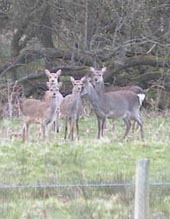 There is considerable debate over the origin of Sika (Cervus
nippon) which have a number of distinct races, the principal
ones being Formosan, Manchurian and Japanese. Whilst there are
physical differences between them – for example, Formosan and
Manchurian tend to be larger than Japanese; Manchurian stags have
wider spread antlers, with a reddish velvet in contrast to the
black of the Japanese; and Formosan Sika have a yellowish brown
summer coat, changing to a light brown in winter rather than the
grey of Japanese - taxonomists are not agreed on the origins of
the races, and conflicting views exist over hybridisation with
Chinese Wapiti leading to the mainland races. The issue of hybridisation
with Red deer has received sensational coverage in the UK popular
press of late, generating a need for more research and a greater
understanding of Sika, their origins and their future. There is considerable debate over the origin of Sika (Cervus
nippon) which have a number of distinct races, the principal
ones being Formosan, Manchurian and Japanese. Whilst there are
physical differences between them – for example, Formosan and
Manchurian tend to be larger than Japanese; Manchurian stags have
wider spread antlers, with a reddish velvet in contrast to the
black of the Japanese; and Formosan Sika have a yellowish brown
summer coat, changing to a light brown in winter rather than the
grey of Japanese - taxonomists are not agreed on the origins of
the races, and conflicting views exist over hybridisation with
Chinese Wapiti leading to the mainland races. The issue of hybridisation
with Red deer has received sensational coverage in the UK popular
press of late, generating a need for more research and a greater
understanding of Sika, their origins and their future.
Having acknowledged the academic debate involving
Sika in general, this article shall concentrate on Japanese Sika
(Cervus nippon nippon), drawing on practical experience
of the herd local to the Purbeck region of Dorset.
HISTORY AND DISTRIBUTION
Japanese Sika were probably first brought to
England in 1860 when a pair were presented to the Zoological Society
of London and exhibited in Regent’s Park. Thereafter many parks
and zoological gardens throughout Britain came to introduce Sika.
Escapees and deliberate releases led to feral Sika faring very
differently across England, Scotland and Ireland with their greatest
success in the latter two countries. The current national distribution
reveals a widespread if haphazard range. It is interesting that
of the eleven areas in England recorded as having feral Sika in
1964 (Whitehead), only in South-East Dorset and the southern part
of the New Forest can they be said to have truly flourished.
Sika arrived in Dorset through two separate
introductions: the first in 1895 at Hyde House Park north of Wareham
and a second on Brownsea Island in Poole Harbour the following
year. Whilst it is believed that the Sika released onto Brownsea
Island started to swim ashore on the night of their release, the
first escape from Hyde House was not recorded by the neighbouring
Trigan Estate until 1927. There were further escapes from Hyde
House during the 1930s, and the whole herd was released during
the Second World War when the government took over the running
of the estate. The South Dorset distribution of Sika lies within
the Poole Basin but is spreading beyond the normally defined limits
of Poole in the East, Bere Regis in the North and Dorchester in
the West.
By comparison, Sika were introduced into the
New Forest when a pair were given to John, second Baron Montague
of Beaulieu, by King Edward VII from his Windsor estate just after
the turn of the century. This first pair was penned at Thorns
Beach but escaped into Sowley Wood the same year. A second pair
arrived a year later and were released in Ashen Wood. The present
New Forest herd originated from these animals and so prolific
was it that culling became necessary by 1930.
DESCRIPTION
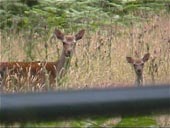 Sika calves at birth have a distinctive baby coat similar to the
summer coat of the hind, albeit browner and with fewer spots.
The caudal patch is much reduced in size and with very little
pure white, most of the hairs being fawn coloured and lacking
the normal black surround. Between one and two months of
age the black border to the caudal patch begins to become
more prominent, starting at the root of the tail and gradually
spreading down either side till it is complete at about three
months. From two months the bright baby coat starts to fade and
the white markings on the flanks become less pronounced. By the
third month the calf is nearly in its winter coat, with the change
complete when the hinds’ coats are still at their brightest or
just beginning to fade. Sika calves at birth have a distinctive baby coat similar to the
summer coat of the hind, albeit browner and with fewer spots.
The caudal patch is much reduced in size and with very little
pure white, most of the hairs being fawn coloured and lacking
the normal black surround. Between one and two months of
age the black border to the caudal patch begins to become
more prominent, starting at the root of the tail and gradually
spreading down either side till it is complete at about three
months. From two months the bright baby coat starts to fade and
the white markings on the flanks become less pronounced. By the
third month the calf is nearly in its winter coat, with the change
complete when the hinds’ coats are still at their brightest or
just beginning to fade.
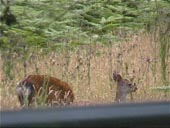 Adults in summer coat are a brighter chestnut than their newly
born calves and have a greater variety in the quantity and type
of white spotting and harnessing, which usually includes a row
of white spots down either side of the dark dorsal stripe. Stags
typically appear darker than hinds at all times of the year. The
winter coat of the hind is a fairly uniform light grey, lighter
on the neck and under parts with occasional faint spotting on
the flanks, presumably faded remnants of the white spots of the
summer coat. The stags are notably darker around the neck and
shoulders and may also show white spots bordering the dorsal stripe.
In all adults and older calves there is a light coloured band
in a shallow U running from between the eyes up towards the ears
- a distinguishing feature of Sika. Adults in summer coat are a brighter chestnut than their newly
born calves and have a greater variety in the quantity and type
of white spotting and harnessing, which usually includes a row
of white spots down either side of the dark dorsal stripe. Stags
typically appear darker than hinds at all times of the year. The
winter coat of the hind is a fairly uniform light grey, lighter
on the neck and under parts with occasional faint spotting on
the flanks, presumably faded remnants of the white spots of the
summer coat. The stags are notably darker around the neck and
shoulders and may also show white spots bordering the dorsal stripe.
In all adults and older calves there is a light coloured band
in a shallow U running from between the eyes up towards the ears
- a distinguishing feature of Sika.
In both summer and winter coats, adults may
or may not have a black line down the dorsal surface of the tail.
When present it can vary between thin and scarcely visible to
broad and obvious. These pelage differences do tend to fuel speculation
about the hybridisation factor among Sika mentioned above. Less
varied is the metatarsal gland conspicuously outlined in white
on all Sika except very young calves in their baby coat.
ANTLER DEVELOPMENT
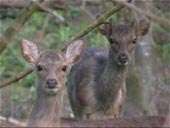 Stag calves begin to develop pedicles at six months and these
produce single spikes in their second year. These spikes can vary
considerably in length from about 6 cm to as much as 25 cm and,
as one might expect, the weaker prickets will have spikes of differing
lengths. Occasionally a stag at this age might have one or two
top forks, but normally a pricket’s un-branched spikes are replaced
in its third year by 6 points. In its fourth or possibly fifth
year and thereafter a stag will carry a full rack of 8 points. Stag calves begin to develop pedicles at six months and these
produce single spikes in their second year. These spikes can vary
considerably in length from about 6 cm to as much as 25 cm and,
as one might expect, the weaker prickets will have spikes of differing
lengths. Occasionally a stag at this age might have one or two
top forks, but normally a pricket’s un-branched spikes are replaced
in its third year by 6 points. In its fourth or possibly fifth
year and thereafter a stag will carry a full rack of 8 points.
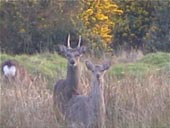 It is relatively common for stags to develop 7 point
heads as adults, where the side tine in the top fork fails to
fully develop for one reason or another. How long a stag remains
in his prime with a full head before beginning to ‘go back’ is
unclear, but it seems likely that this would be between 3-5 years
(i.e. aged 7-9 years). What is also worth noting is the
whitening of the tines through the course of the winter and the
noticeable antler chipping which occurs from the stag’s arrival
in hard horn through to casting in April. It is relatively common for stags to develop 7 point
heads as adults, where the side tine in the top fork fails to
fully develop for one reason or another. How long a stag remains
in his prime with a full head before beginning to ‘go back’ is
unclear, but it seems likely that this would be between 3-5 years
(i.e. aged 7-9 years). What is also worth noting is the
whitening of the tines through the course of the winter and the
noticeable antler chipping which occurs from the stag’s arrival
in hard horn through to casting in April.
HABITAT
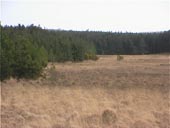 Sika have a preference for an acid soil habitat to which they
gravitate, especially in winter. Pine forests, Sitka Spruce, Larch
with boggy ground and heather all suit them. The Purbeck region
adds broad-leafed woodland, permanent pasture, arable land and
banks of gorse to the aforementioned eco-systems and offers sufficient
choice, it would appear, to keep even the most discerning Sika
contented. Heath and rhododendron, classic flora of acidic soils,
are particularly widespread here. The coastal range of South Dorset
includes acid sands and gravel of the London and Reading Beds
and Bagshot Sands, but the area also includes outcrops of chalk
and Purbeck limestone. The more inaccessible parts of the region,
which are not farmed intensively and enjoy minimal human disturbance,
in particular promote a thriving population of high density. This,
coupled with a tendency towards localised migration onto the richer
pickings of cultivated land in the summer, can bring Sika into
conflict with agrarian interests. The twin aims of maintaining
healthy deer free from the stress of over-population and avoiding
high levels of crop damage necessitate a considered deer management
plan. Sika have a preference for an acid soil habitat to which they
gravitate, especially in winter. Pine forests, Sitka Spruce, Larch
with boggy ground and heather all suit them. The Purbeck region
adds broad-leafed woodland, permanent pasture, arable land and
banks of gorse to the aforementioned eco-systems and offers sufficient
choice, it would appear, to keep even the most discerning Sika
contented. Heath and rhododendron, classic flora of acidic soils,
are particularly widespread here. The coastal range of South Dorset
includes acid sands and gravel of the London and Reading Beds
and Bagshot Sands, but the area also includes outcrops of chalk
and Purbeck limestone. The more inaccessible parts of the region,
which are not farmed intensively and enjoy minimal human disturbance,
in particular promote a thriving population of high density. This,
coupled with a tendency towards localised migration onto the richer
pickings of cultivated land in the summer, can bring Sika into
conflict with agrarian interests. The twin aims of maintaining
healthy deer free from the stress of over-population and avoiding
high levels of crop damage necessitate a considered deer management
plan.
FEEDING HABITS
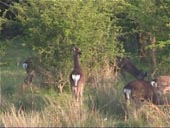 Sika are predominantly grazers, feeding heavily on grasses, broadleaf
buds and twigs, heather, fruits, fungi and acorns. Their success
in Scotland proves that they can adapt to the relative sparseness
of thick conifers and rough grazing. They are fond of water-bank
growth and are keen on hazel, which they are prone to chew and
strip. Whilst the author’s experience of New Forest Sika is very
limited, a clear distinction has been drawn (The Social Organisation
and Ecology of the Japanese Sika Deer in Southern England,
JCE Mann, PhD Thesis, Southampton University, 1982) between these
as browsers and the Sika of Dorset as grazers. In Purbeck they
can be seen doing both, nevertheless they are predominantly grazers. Sika are predominantly grazers, feeding heavily on grasses, broadleaf
buds and twigs, heather, fruits, fungi and acorns. Their success
in Scotland proves that they can adapt to the relative sparseness
of thick conifers and rough grazing. They are fond of water-bank
growth and are keen on hazel, which they are prone to chew and
strip. Whilst the author’s experience of New Forest Sika is very
limited, a clear distinction has been drawn (The Social Organisation
and Ecology of the Japanese Sika Deer in Southern England,
JCE Mann, PhD Thesis, Southampton University, 1982) between these
as browsers and the Sika of Dorset as grazers. In Purbeck they
can be seen doing both, nevertheless they are predominantly grazers.
Although Sika generally feed at night, they
can occasionally be seen feeding in undisturbed areas at almost
any time of the day. As a rule one would expect to see these crepuscular
(meaning preference for twilight) animals in the last two hours
of daylight or during the first hour after dawn on their way to
and from their feeding grounds. Whilst in the evening they will
probably feed their way out of cover, in the early morning they
seem to be single-mindedly travelling back to cover when observed.
They are certainly less affected by inclement weather when compared
with Roe deer, being quite happy to feed in steady rain, although
they are less inclined towards stormy conditions or strong cold
wind.
SOCIAL STRUCTURE
The social structure of Sika seems to vary
from region to region. In Dorset the picture of single sex groups
throughout the year, with the exception of the rut (mid-September
to the end of November) does not generally apply.
From November onwards one does tend to find
hinds and calves congregating together, with the stags exhausted
from the rut seeking the solace of stag groups. And in March the
stronger yearling stag calves may well leave their mothers to
join a stag group. However, in April one will find stags coming
into velvet mixing with hinds until about August when, once they
are in hard horn, they seem to separate out with stag groups forming
once again. There is considerable variation to any one image of
social structure as much depends upon the relative health of the
animals concerned. Sparring will occur in early September as the
stags start to reach their peak condition, thickening out significantly
in the neck and shoulders, as well as developing a strong body
aroma. But at this stage big stags are still prepared to tolerate
the presence of prickets and lesser males. By mid- to late September
the bigger stags capable of defending territory will be doing
so without any tolerance of a viable competitor. The younger stags
will satellite around the master stags and try to take advantage
of their fatigue towards the end of the rut, thus providing these
youngsters with a much anticipated opportunity to cover a hind.
With calves and followers, the winter hind groups distinct in
their congregation can grow to a significant size, with 15-20
animals not being unusual.
An autumn reverse migration from cultivated
land back onto sparser, undisturbed ground and traditional rutting
stands is a characteristic prelude to the rut in many parts of
Purbeck. This underlines the need for careful planning of any
deer management which should take allowance of such population
dynamics and must involve careful liaison with local farming and
forestry interests.
ANNUAL CYCLE
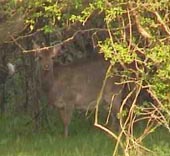 Most calves are born in late May and through June, although they
can be born well outside this period. The particular timing for
a hind calving has much to do with her condition and body weight
through her period of gravidity and, in the case of the occasional
precocious pregnancy, sexual maturity at the time of the rut.
Weaker hinds will not go to full term. Sika have a high reproductive
success rate, especially in a strong herd with a favourable habitat.
Analysis of one local deer management group’s cull records and
data from 1998 revealed a fecundity rate of over 92.6% in mature
hinds culled after 1 December and a combined rate of 90.5% in
mature and yearling hinds. Sika drop single calves, with the stronger
stag calves leaving their mothers for stag groups in March and
the yearling hind calves being driven away at their mother’s next
calving. Unlike Roe they do not appear to have a significant mortality
rate over their first winter. Up to about five months of age calves
can be identified by their size, but they grow so fast that thereafter
they are less easily recognised unless they are standing with
their mothers. However, the fact that they only have one pair
of molars means that a calf’s jaw is appreciably shorter, giving
the head a chubbier appearance. By eight months they may only
be two inches shorter at the shoulder than the hind and 10 lbs
lighter, although the heavier stag calf may actually weigh the
same. As the winter develops, the darker coat of a stag calf will
generally become more noticeable and by about March they are showing
small pedicles, although not absolutely all stag calves develop
these. Most calves are born in late May and through June, although they
can be born well outside this period. The particular timing for
a hind calving has much to do with her condition and body weight
through her period of gravidity and, in the case of the occasional
precocious pregnancy, sexual maturity at the time of the rut.
Weaker hinds will not go to full term. Sika have a high reproductive
success rate, especially in a strong herd with a favourable habitat.
Analysis of one local deer management group’s cull records and
data from 1998 revealed a fecundity rate of over 92.6% in mature
hinds culled after 1 December and a combined rate of 90.5% in
mature and yearling hinds. Sika drop single calves, with the stronger
stag calves leaving their mothers for stag groups in March and
the yearling hind calves being driven away at their mother’s next
calving. Unlike Roe they do not appear to have a significant mortality
rate over their first winter. Up to about five months of age calves
can be identified by their size, but they grow so fast that thereafter
they are less easily recognised unless they are standing with
their mothers. However, the fact that they only have one pair
of molars means that a calf’s jaw is appreciably shorter, giving
the head a chubbier appearance. By eight months they may only
be two inches shorter at the shoulder than the hind and 10 lbs
lighter, although the heavier stag calf may actually weigh the
same. As the winter develops, the darker coat of a stag calf will
generally become more noticeable and by about March they are showing
small pedicles, although not absolutely all stag calves develop
these.
During the rut, stags mark out and defend a
territory rather than a harem as with Red stags. However, the
distinction is blurred by the fact that stags, while patrolling
the boundaries of their territories, will seek out hinds to try
to subdue them or to drive them to a rutting stand where, if in
season, the stag will cover them. Hinds will still need to move
out from any rutting stand in the evening to feed and so the need
for the stag to patrol his boundaries, see off interlopers and
gather up hinds goes on. Hinds can be covered when acquiescent
as well as when apparently resistant. A hind in season might bleat
a protest at an interested stag which can lead to all stags within
earshot turning up to contest her, frequently involving the hind
being chased around by a number of suitors. Presumably it is the
strongest who wins out and frequently this stag will prefer to
force himself on the hind rather than wait for compliance.
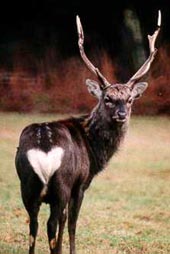 Territories are marked by
a stag thrashing the ground cover of heather and gorse with his
antlers, leaving circular patches at intervals along the boundaries
and some fraying of perimeter trees. Fighting between stags is
commonplace, as is apparent from the number of heads with damaged
or missing tines and the limping stags which can appear after
the rut. Wallowing is universal and these sites also indicate
an actively territory. Stags generally have a filthy matted
appearance, particularly around the neck and shoulders, from wallowing
and this ‘war paint’ is embellished by the fronds of grass, heather
and bracken which can stick in their antlers as a result of fraying.
They complete this impressive ensemble by being at peak condition
by the start of the rut, having built up a considerable amount
of fat deposit, with an enlarged and shaggy neck. They also stink
of both musk and their own urine which they add to their wallow.
Some stags also develop what are referred to as ‘milky tears’
- a thick fluid, probably from an orbital gland. Territories are marked by
a stag thrashing the ground cover of heather and gorse with his
antlers, leaving circular patches at intervals along the boundaries
and some fraying of perimeter trees. Fighting between stags is
commonplace, as is apparent from the number of heads with damaged
or missing tines and the limping stags which can appear after
the rut. Wallowing is universal and these sites also indicate
an actively territory. Stags generally have a filthy matted
appearance, particularly around the neck and shoulders, from wallowing
and this ‘war paint’ is embellished by the fronds of grass, heather
and bracken which can stick in their antlers as a result of fraying.
They complete this impressive ensemble by being at peak condition
by the start of the rut, having built up a considerable amount
of fat deposit, with an enlarged and shaggy neck. They also stink
of both musk and their own urine which they add to their wallow.
Some stags also develop what are referred to as ‘milky tears’
- a thick fluid, probably from an orbital gland.
Once the rut is over, stags return to the normal
routine of crepuscular movement and nocturnal grazing to begin
to recover both weight and strength after the stresses and strains
associated with mating and defending a territory. Traditional
rutting stands having now been vacated, stags become much more
evident and begin to congregate in stag groups again, although
mixed groupings may also be seen.
VOICE AND CALLS
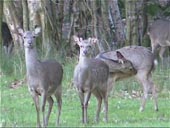 The astonishing rutting call associated with Sika stags is primarily
designed to attract the attentions of a hind in season. Whilst
the call which has terrified many an unsuspecting stranger to
the rut into thinking they have just heard some terrible murder
take place is perhaps the most notorious, it is by no means the
only rutting sound to be heard. A single whistle, rising to a
peak before tailing off and usually repeated three times is perhaps
the commonest call of the rut. A noise rather like a witch’s cackle
("yak, yak, yak") registers a stag’s annoyance and is often followed
by the sound of direct confrontation - clashing antlers. If one
is able to get close to a hind in season one might be able to
hear her bleat, indicating receptiveness. The astonishing rutting call associated with Sika stags is primarily
designed to attract the attentions of a hind in season. Whilst
the call which has terrified many an unsuspecting stranger to
the rut into thinking they have just heard some terrible murder
take place is perhaps the most notorious, it is by no means the
only rutting sound to be heard. A single whistle, rising to a
peak before tailing off and usually repeated three times is perhaps
the commonest call of the rut. A noise rather like a witch’s cackle
("yak, yak, yak") registers a stag’s annoyance and is often followed
by the sound of direct confrontation - clashing antlers. If one
is able to get close to a hind in season one might be able to
hear her bleat, indicating receptiveness.
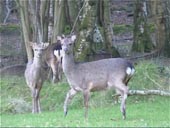 In addition to calls associated with the rut, Sika have a distinctive
alarm whistle or squeak, which both hinds and stags can give,
although the latter is of a lower pitch. When uncertain of something
or unsure of the source of another deer’s alarm, Sika will face
the direction of potential danger and move their heads up and
down in nervousness or crane their necks from side to side trying
to get a better view. If still undecided they might make a few
hesitant steps forward, raising first one forefoot with the ‘forearm’
or shank horizontal and the foot pointing down, hold this position
for a short while, then put the foot down and repeat the performance
with the other forefoot (rather like a Lippitzaner in slow time).
Although hardly visible head on, the erectile hairs of the caudal
patch usually fan out to display a state of alarm to any other
deer. When the degree of alarm becomes too much to stay still,
Sika will bound off, jumping off all four feet together as though
mounted on springs. Reminiscent of African plains antelope, this
unusual movement is known as pronking. In addition to calls associated with the rut, Sika have a distinctive
alarm whistle or squeak, which both hinds and stags can give,
although the latter is of a lower pitch. When uncertain of something
or unsure of the source of another deer’s alarm, Sika will face
the direction of potential danger and move their heads up and
down in nervousness or crane their necks from side to side trying
to get a better view. If still undecided they might make a few
hesitant steps forward, raising first one forefoot with the ‘forearm’
or shank horizontal and the foot pointing down, hold this position
for a short while, then put the foot down and repeat the performance
with the other forefoot (rather like a Lippitzaner in slow time).
Although hardly visible head on, the erectile hairs of the caudal
patch usually fan out to display a state of alarm to any other
deer. When the degree of alarm becomes too much to stay still,
Sika will bound off, jumping off all four feet together as though
mounted on springs. Reminiscent of African plains antelope, this
unusual movement is known as pronking.
|

 There is considerable debate over the origin of Sika (Cervus
nippon) which have a number of distinct races, the principal
ones being Formosan, Manchurian and Japanese. Whilst there are
physical differences between them – for example, Formosan and
Manchurian tend to be larger than Japanese; Manchurian stags have
wider spread antlers, with a reddish velvet in contrast to the
black of the Japanese; and Formosan Sika have a yellowish brown
summer coat, changing to a light brown in winter rather than the
grey of Japanese - taxonomists are not agreed on the origins of
the races, and conflicting views exist over hybridisation with
Chinese Wapiti leading to the mainland races. The issue of hybridisation
with Red deer has received sensational coverage in the UK popular
press of late, generating a need for more research and a greater
understanding of Sika, their origins and their future.
There is considerable debate over the origin of Sika (Cervus
nippon) which have a number of distinct races, the principal
ones being Formosan, Manchurian and Japanese. Whilst there are
physical differences between them – for example, Formosan and
Manchurian tend to be larger than Japanese; Manchurian stags have
wider spread antlers, with a reddish velvet in contrast to the
black of the Japanese; and Formosan Sika have a yellowish brown
summer coat, changing to a light brown in winter rather than the
grey of Japanese - taxonomists are not agreed on the origins of
the races, and conflicting views exist over hybridisation with
Chinese Wapiti leading to the mainland races. The issue of hybridisation
with Red deer has received sensational coverage in the UK popular
press of late, generating a need for more research and a greater
understanding of Sika, their origins and their future. Sika calves at birth have a distinctive baby coat similar to the
summer coat of the hind, albeit browner and with fewer spots.
The caudal patch is much reduced in size and with very little
pure white, most of the hairs being fawn coloured and lacking
the normal black surround. Between one and two months of
age the black border to the caudal patch begins to become
more prominent, starting at the root of the tail and gradually
spreading down either side till it is complete at about three
months. From two months the bright baby coat starts to fade and
the white markings on the flanks become less pronounced. By the
third month the calf is nearly in its winter coat, with the change
complete when the hinds’ coats are still at their brightest or
just beginning to fade.
Sika calves at birth have a distinctive baby coat similar to the
summer coat of the hind, albeit browner and with fewer spots.
The caudal patch is much reduced in size and with very little
pure white, most of the hairs being fawn coloured and lacking
the normal black surround. Between one and two months of
age the black border to the caudal patch begins to become
more prominent, starting at the root of the tail and gradually
spreading down either side till it is complete at about three
months. From two months the bright baby coat starts to fade and
the white markings on the flanks become less pronounced. By the
third month the calf is nearly in its winter coat, with the change
complete when the hinds’ coats are still at their brightest or
just beginning to fade. Adults in summer coat are a brighter chestnut than their newly
born calves and have a greater variety in the quantity and type
of white spotting and harnessing, which usually includes a row
of white spots down either side of the dark dorsal stripe. Stags
typically appear darker than hinds at all times of the year. The
winter coat of the hind is a fairly uniform light grey, lighter
on the neck and under parts with occasional faint spotting on
the flanks, presumably faded remnants of the white spots of the
summer coat. The stags are notably darker around the neck and
shoulders and may also show white spots bordering the dorsal stripe.
In all adults and older calves there is a light coloured band
in a shallow U running from between the eyes up towards the ears
- a distinguishing feature of Sika.
Adults in summer coat are a brighter chestnut than their newly
born calves and have a greater variety in the quantity and type
of white spotting and harnessing, which usually includes a row
of white spots down either side of the dark dorsal stripe. Stags
typically appear darker than hinds at all times of the year. The
winter coat of the hind is a fairly uniform light grey, lighter
on the neck and under parts with occasional faint spotting on
the flanks, presumably faded remnants of the white spots of the
summer coat. The stags are notably darker around the neck and
shoulders and may also show white spots bordering the dorsal stripe.
In all adults and older calves there is a light coloured band
in a shallow U running from between the eyes up towards the ears
- a distinguishing feature of Sika. Stag calves begin to develop pedicles at six months and these
produce single spikes in their second year. These spikes can vary
considerably in length from about 6 cm to as much as 25 cm and,
as one might expect, the weaker prickets will have spikes of differing
lengths. Occasionally a stag at this age might have one or two
top forks, but normally a pricket’s un-branched spikes are replaced
in its third year by 6 points. In its fourth or possibly fifth
year and thereafter a stag will carry a full rack of 8 points.
Stag calves begin to develop pedicles at six months and these
produce single spikes in their second year. These spikes can vary
considerably in length from about 6 cm to as much as 25 cm and,
as one might expect, the weaker prickets will have spikes of differing
lengths. Occasionally a stag at this age might have one or two
top forks, but normally a pricket’s un-branched spikes are replaced
in its third year by 6 points. In its fourth or possibly fifth
year and thereafter a stag will carry a full rack of 8 points.
 It is relatively common for stags to develop 7 point
heads as adults, where the side tine in the top fork fails to
fully develop for one reason or another. How long a stag remains
in his prime with a full head before beginning to ‘go back’ is
unclear, but it seems likely that this would be between 3-5 years
(i.e. aged 7-9 years). What is also worth noting is the
whitening of the tines through the course of the winter and the
noticeable antler chipping which occurs from the stag’s arrival
in hard horn through to casting in April.
It is relatively common for stags to develop 7 point
heads as adults, where the side tine in the top fork fails to
fully develop for one reason or another. How long a stag remains
in his prime with a full head before beginning to ‘go back’ is
unclear, but it seems likely that this would be between 3-5 years
(i.e. aged 7-9 years). What is also worth noting is the
whitening of the tines through the course of the winter and the
noticeable antler chipping which occurs from the stag’s arrival
in hard horn through to casting in April. Sika have a preference for an acid soil habitat to which they
gravitate, especially in winter. Pine forests, Sitka Spruce, Larch
with boggy ground and heather all suit them. The Purbeck region
adds broad-leafed woodland, permanent pasture, arable land and
banks of gorse to the aforementioned eco-systems and offers sufficient
choice, it would appear, to keep even the most discerning Sika
contented. Heath and rhododendron, classic flora of acidic soils,
are particularly widespread here. The coastal range of South Dorset
includes acid sands and gravel of the London and Reading Beds
and Bagshot Sands, but the area also includes outcrops of chalk
and Purbeck limestone. The more inaccessible parts of the region,
which are not farmed intensively and enjoy minimal human disturbance,
in particular promote a thriving population of high density. This,
coupled with a tendency towards localised migration onto the richer
pickings of cultivated land in the summer, can bring Sika into
conflict with agrarian interests. The twin aims of maintaining
healthy deer free from the stress of over-population and avoiding
high levels of crop damage necessitate a considered deer management
plan.
Sika have a preference for an acid soil habitat to which they
gravitate, especially in winter. Pine forests, Sitka Spruce, Larch
with boggy ground and heather all suit them. The Purbeck region
adds broad-leafed woodland, permanent pasture, arable land and
banks of gorse to the aforementioned eco-systems and offers sufficient
choice, it would appear, to keep even the most discerning Sika
contented. Heath and rhododendron, classic flora of acidic soils,
are particularly widespread here. The coastal range of South Dorset
includes acid sands and gravel of the London and Reading Beds
and Bagshot Sands, but the area also includes outcrops of chalk
and Purbeck limestone. The more inaccessible parts of the region,
which are not farmed intensively and enjoy minimal human disturbance,
in particular promote a thriving population of high density. This,
coupled with a tendency towards localised migration onto the richer
pickings of cultivated land in the summer, can bring Sika into
conflict with agrarian interests. The twin aims of maintaining
healthy deer free from the stress of over-population and avoiding
high levels of crop damage necessitate a considered deer management
plan. Sika are predominantly grazers, feeding heavily on grasses, broadleaf
buds and twigs, heather, fruits, fungi and acorns. Their success
in Scotland proves that they can adapt to the relative sparseness
of thick conifers and rough grazing. They are fond of water-bank
growth and are keen on hazel, which they are prone to chew and
strip. Whilst the author’s experience of New Forest Sika is very
limited, a clear distinction has been drawn (The Social Organisation
and Ecology of the Japanese Sika Deer in Southern England,
JCE Mann, PhD Thesis, Southampton University, 1982) between these
as browsers and the Sika of Dorset as grazers. In Purbeck they
can be seen doing both, nevertheless they are predominantly grazers.
Sika are predominantly grazers, feeding heavily on grasses, broadleaf
buds and twigs, heather, fruits, fungi and acorns. Their success
in Scotland proves that they can adapt to the relative sparseness
of thick conifers and rough grazing. They are fond of water-bank
growth and are keen on hazel, which they are prone to chew and
strip. Whilst the author’s experience of New Forest Sika is very
limited, a clear distinction has been drawn (The Social Organisation
and Ecology of the Japanese Sika Deer in Southern England,
JCE Mann, PhD Thesis, Southampton University, 1982) between these
as browsers and the Sika of Dorset as grazers. In Purbeck they
can be seen doing both, nevertheless they are predominantly grazers. Most calves are born in late May and through June, although they
can be born well outside this period. The particular timing for
a hind calving has much to do with her condition and body weight
through her period of gravidity and, in the case of the occasional
precocious pregnancy, sexual maturity at the time of the rut.
Weaker hinds will not go to full term. Sika have a high reproductive
success rate, especially in a strong herd with a favourable habitat.
Analysis of one local deer management group’s cull records and
data from 1998 revealed a fecundity rate of over 92.6% in mature
hinds culled after 1 December and a combined rate of 90.5% in
mature and yearling hinds. Sika drop single calves, with the stronger
stag calves leaving their mothers for stag groups in March and
the yearling hind calves being driven away at their mother’s next
calving. Unlike Roe they do not appear to have a significant mortality
rate over their first winter. Up to about five months of age calves
can be identified by their size, but they grow so fast that thereafter
they are less easily recognised unless they are standing with
their mothers. However, the fact that they only have one pair
of molars means that a calf’s jaw is appreciably shorter, giving
the head a chubbier appearance. By eight months they may only
be two inches shorter at the shoulder than the hind and 10 lbs
lighter, although the heavier stag calf may actually weigh the
same. As the winter develops, the darker coat of a stag calf will
generally become more noticeable and by about March they are showing
small pedicles, although not absolutely all stag calves develop
these.
Most calves are born in late May and through June, although they
can be born well outside this period. The particular timing for
a hind calving has much to do with her condition and body weight
through her period of gravidity and, in the case of the occasional
precocious pregnancy, sexual maturity at the time of the rut.
Weaker hinds will not go to full term. Sika have a high reproductive
success rate, especially in a strong herd with a favourable habitat.
Analysis of one local deer management group’s cull records and
data from 1998 revealed a fecundity rate of over 92.6% in mature
hinds culled after 1 December and a combined rate of 90.5% in
mature and yearling hinds. Sika drop single calves, with the stronger
stag calves leaving their mothers for stag groups in March and
the yearling hind calves being driven away at their mother’s next
calving. Unlike Roe they do not appear to have a significant mortality
rate over their first winter. Up to about five months of age calves
can be identified by their size, but they grow so fast that thereafter
they are less easily recognised unless they are standing with
their mothers. However, the fact that they only have one pair
of molars means that a calf’s jaw is appreciably shorter, giving
the head a chubbier appearance. By eight months they may only
be two inches shorter at the shoulder than the hind and 10 lbs
lighter, although the heavier stag calf may actually weigh the
same. As the winter develops, the darker coat of a stag calf will
generally become more noticeable and by about March they are showing
small pedicles, although not absolutely all stag calves develop
these. Territories are marked by
a stag thrashing the ground cover of heather and gorse with his
antlers, leaving circular patches at intervals along the boundaries
and some fraying of perimeter trees. Fighting between stags is
commonplace, as is apparent from the number of heads with damaged
or missing tines and the limping stags which can appear after
the rut. Wallowing is universal and these sites also indicate
an actively territory. Stags generally have a filthy matted
appearance, particularly around the neck and shoulders, from wallowing
and this ‘war paint’ is embellished by the fronds of grass, heather
and bracken which can stick in their antlers as a result of fraying.
They complete this impressive ensemble by being at peak condition
by the start of the rut, having built up a considerable amount
of fat deposit, with an enlarged and shaggy neck. They also stink
of both musk and their own urine which they add to their wallow.
Some stags also develop what are referred to as ‘milky tears’
- a thick fluid, probably from an orbital gland.
Territories are marked by
a stag thrashing the ground cover of heather and gorse with his
antlers, leaving circular patches at intervals along the boundaries
and some fraying of perimeter trees. Fighting between stags is
commonplace, as is apparent from the number of heads with damaged
or missing tines and the limping stags which can appear after
the rut. Wallowing is universal and these sites also indicate
an actively territory. Stags generally have a filthy matted
appearance, particularly around the neck and shoulders, from wallowing
and this ‘war paint’ is embellished by the fronds of grass, heather
and bracken which can stick in their antlers as a result of fraying.
They complete this impressive ensemble by being at peak condition
by the start of the rut, having built up a considerable amount
of fat deposit, with an enlarged and shaggy neck. They also stink
of both musk and their own urine which they add to their wallow.
Some stags also develop what are referred to as ‘milky tears’
- a thick fluid, probably from an orbital gland. The astonishing rutting call associated with Sika stags is primarily
designed to attract the attentions of a hind in season. Whilst
the call which has terrified many an unsuspecting stranger to
the rut into thinking they have just heard some terrible murder
take place is perhaps the most notorious, it is by no means the
only rutting sound to be heard. A single whistle, rising to a
peak before tailing off and usually repeated three times is perhaps
the commonest call of the rut. A noise rather like a witch’s cackle
("yak, yak, yak") registers a stag’s annoyance and is often followed
by the sound of direct confrontation - clashing antlers. If one
is able to get close to a hind in season one might be able to
hear her bleat, indicating receptiveness.
The astonishing rutting call associated with Sika stags is primarily
designed to attract the attentions of a hind in season. Whilst
the call which has terrified many an unsuspecting stranger to
the rut into thinking they have just heard some terrible murder
take place is perhaps the most notorious, it is by no means the
only rutting sound to be heard. A single whistle, rising to a
peak before tailing off and usually repeated three times is perhaps
the commonest call of the rut. A noise rather like a witch’s cackle
("yak, yak, yak") registers a stag’s annoyance and is often followed
by the sound of direct confrontation - clashing antlers. If one
is able to get close to a hind in season one might be able to
hear her bleat, indicating receptiveness. In addition to calls associated with the rut, Sika have a distinctive
alarm whistle or squeak, which both hinds and stags can give,
although the latter is of a lower pitch. When uncertain of something
or unsure of the source of another deer’s alarm, Sika will face
the direction of potential danger and move their heads up and
down in nervousness or crane their necks from side to side trying
to get a better view. If still undecided they might make a few
hesitant steps forward, raising first one forefoot with the ‘forearm’
or shank horizontal and the foot pointing down, hold this position
for a short while, then put the foot down and repeat the performance
with the other forefoot (rather like a Lippitzaner in slow time).
Although hardly visible head on, the erectile hairs of the caudal
patch usually fan out to display a state of alarm to any other
deer. When the degree of alarm becomes too much to stay still,
Sika will bound off, jumping off all four feet together as though
mounted on springs. Reminiscent of African plains antelope, this
unusual movement is known as pronking.
In addition to calls associated with the rut, Sika have a distinctive
alarm whistle or squeak, which both hinds and stags can give,
although the latter is of a lower pitch. When uncertain of something
or unsure of the source of another deer’s alarm, Sika will face
the direction of potential danger and move their heads up and
down in nervousness or crane their necks from side to side trying
to get a better view. If still undecided they might make a few
hesitant steps forward, raising first one forefoot with the ‘forearm’
or shank horizontal and the foot pointing down, hold this position
for a short while, then put the foot down and repeat the performance
with the other forefoot (rather like a Lippitzaner in slow time).
Although hardly visible head on, the erectile hairs of the caudal
patch usually fan out to display a state of alarm to any other
deer. When the degree of alarm becomes too much to stay still,
Sika will bound off, jumping off all four feet together as though
mounted on springs. Reminiscent of African plains antelope, this
unusual movement is known as pronking.